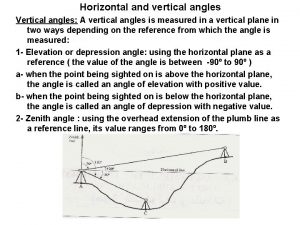Vertical shifts up A familiar example Vertical shift













- Slides: 13

Vertical shifts (up) A familiar example: Vertical shift up 3: y-values each increase by 3 graph is shifted up 3 units

More vertical shifts (down) Original curve: Vertical shift down 5: y-values each decrease by 5 graph is shifted down 5 units

Horizontal shifts (right) Original curve: Horizontal shift right 3: y-values are shifted to the right 3 units graph is shifted right 3 units

More horizontal shifts (left) Original curve: Horizontal shift Left 4: y-values are shifted to the left 4 units graph is shifted left 4 units

Summary of vertical and horizontal shifts Given a function g whose graph is known, and a positive number k, the graph of the function f is: graph of g, shifted up k units graph of g, shifted down k units CAUTION: the signs here may be counter-intuituve! graph of g, shifted right k units graph of g, shifted left k units

Reflections about the x-axis Original curve: undefined if x < 0 Reflected about x-axis: y-values each replaced by their opposite

Reflections about the y-axis Original curve: mirror image of y-values undefined if x < 0 Reflected about y-axis: undefined if x > 0 domain:

Summary of reflections Given a function g whose graph is known, the graph of the function f is: graph of g, reflected about the x-axis domain of f is domain of g graph of g, reflected about the y-axis domain of f is "opposite" of domain of g i. e. if domain of g is [a, b] then domain of f is [-b, -a]

Vertical stretching A cubic polynomial: each y-value doubles

Vertical Shrinking The same cubic: each y-value shrinks by 1/3

Horizontal Stretching The same cubic: Y-values are stretched out from the center

Horizontal shrinking The same cubic

Summary of stretching and shrinking Given a function g whose graph is known, and a positive number c, the graph of the function f is: graph of g, stretched vertically graph of g, shrunk horizontally graph of g, stretched horizontally
 Woodward fieser rules
Woodward fieser rules Aniline uv spectrum
Aniline uv spectrum Cap 221
Cap 221 Bathochromic shift and hypsochromic shift
Bathochromic shift and hypsochromic shift Difference between arithmetic shift and logical shift
Difference between arithmetic shift and logical shift Logical shift and arithmetic shift
Logical shift and arithmetic shift Difference between arithmetic shift and logical shift
Difference between arithmetic shift and logical shift Difference between arithmetic shift and logical shift
Difference between arithmetic shift and logical shift Posselt's diagram
Posselt's diagram Horizontal and vertical shifts
Horizontal and vertical shifts Grafik pencerminan
Grafik pencerminan Vertical lens shift
Vertical lens shift Vertical shift up
Vertical shift up Catford 1965
Catford 1965
























